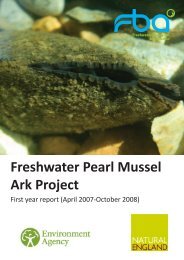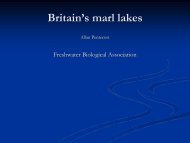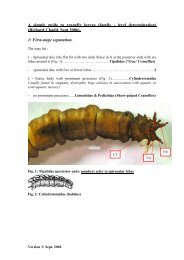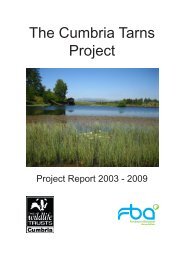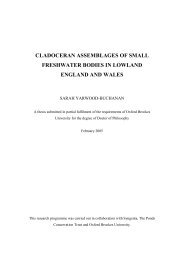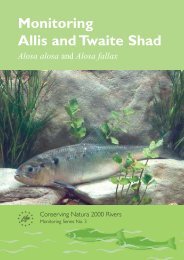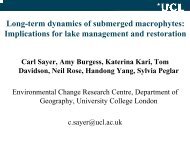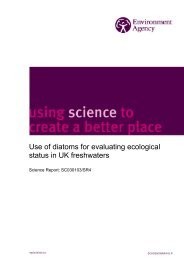Monitoring the Bullhead - European Commission
Monitoring the Bullhead - European Commission
Monitoring the Bullhead - European Commission
Create successful ePaper yourself
Turn your PDF publications into a flip-book with our unique Google optimized e-Paper software.
on <strong>the</strong> Eden in 2002, if incorporating bullhead surveys, may have resulted in saturation of catches with<br />
0+ bullheads, while <strong>the</strong> surveys on <strong>the</strong> Teifi were during <strong>the</strong> recommended period.To solve this<br />
problem, each regional monitoring body may have to adjust part of its monitoring programme, although<br />
this may have implications in terms of manpower resources.This shift in timing of surveys must be<br />
balanced against potential curtailment of surveys due to inclement wea<strong>the</strong>r conditions and high flows.<br />
4.3.3 Survey equipment and safety procedures<br />
Electric fishing is <strong>the</strong> method recommended for sampling bullhead populations in SAC rivers.The<br />
technique is commonly used on a variety of waterbodies throughout <strong>the</strong> UK. Stringent guidelines for<br />
<strong>the</strong> design of gear, operation and safety regulations, produced by <strong>the</strong> Environment Agency and o<strong>the</strong>r<br />
fishery agencies in <strong>the</strong> UK, should be adhered to in all surveys (for example, <strong>the</strong> Environment Agency<br />
Code of Practice for Safety in Electric Fishing Operations 2000). Direct current (DC) or Pulsed Direct<br />
Current (PDC) should be used. Alternating current (AC) must not be used due to its damaging effect<br />
on fish.<br />
All personnel involved in electric fishing activities must have been fully trained to Environment Agency<br />
or equivalent standards, and <strong>the</strong> risks involved and safety procedures fully understood before any<br />
survey work. General equipment and materials (clothing, lifejackets, hand-nets, fish containers,<br />
communication equipment, first-aid kits) should meet <strong>the</strong> recommendations of <strong>the</strong> CEN directive (CEN<br />
Directive for Water Analysis – Sampling of Fish with Electricity:Work Item 230116, revision of PrEN 14011,<br />
October 25, 2001). Before carrying out any fieldwork, a full risk assessment of <strong>the</strong> work should be<br />
produced.This should include procedures for action in case of emergency.<br />
4.3.4 Sampling procedure<br />
<strong>Monitoring</strong> <strong>the</strong> <strong>Bullhead</strong><br />
The methodology recommended for bullheads is calibrated sampling linked to semi-quantitative<br />
surveying of shallow riffles by electric fishing.The procedure is designed for use in wadeable rivers, as<br />
sampling bullheads in large, deep rivers is considered impractical. Multiple electric fishing of a known<br />
area of riffle is used to obtain absolute estimates of population density by an appropriate depletion<br />
model (for example, Carle & Strub or Zippin methods, see Cowx 1983) and derive <strong>the</strong> efficiency of <strong>the</strong><br />
sampling effort or probability of capture (P).This sampling efficiency is <strong>the</strong>n used for calibration against<br />
o<strong>the</strong>r sites where single-run electric fishing is carried out, and a relative measure of density (N<br />
individuals m-2) is derived as (N = P x C) where C is <strong>the</strong> total number of fish caught in one run of<br />
electric fishing (Cowx 1996).<br />
Electric fishing can be carried out ei<strong>the</strong>r using a bankside generator supply or back-pack gear. The<br />
waveform used should be DC or PDC, and <strong>the</strong> power output adjusted prior to surveying to maximise<br />
catch while minimising damage to fish.The length of river to be fished should be identified before<br />
surveying.This is critical if non-portable electric fishing gear is used to ensure sufficient lengths of<br />
anode cable are available. If sampling is part of a quantitative salmonid monitoring programme and stop<br />
nets are used, surveys should take place in an upstream direction from <strong>the</strong> lower stop-net to <strong>the</strong> upper<br />
stop-net.Where surveys are carried out without stop-nets, <strong>the</strong> length of river to be surveyed should<br />
be scrutinised to identify downstream and upstream limits of <strong>the</strong> survey site.<br />
One or two anodes should be used depending on <strong>the</strong> width of river sampled and limitations on<br />
personnel. The anode should be operated in an upstream direction and should cover <strong>the</strong> wetted area<br />
of river ensuring adequate coverage of all available habitats.The anode must not be operated too close<br />
to <strong>the</strong> riverbed, as this may result in immobilization of bullheads in <strong>the</strong> substrate and make capture<br />
difficult. Each anode operator should be supported by two hand-netters (hand-net mesh size of 4 mm)<br />
who should have nets placed in <strong>the</strong> water column behind <strong>the</strong> anode.This is critical in <strong>the</strong> case of<br />
bullhead sampling, as immobilized juveniles may be swept rapidly downstream by <strong>the</strong> current, making<br />
<strong>the</strong>m difficult to capture if <strong>the</strong> net is not placed immediately behind <strong>the</strong> anode.<br />
<strong>Bullhead</strong>s are often immobilized underneath or behind stones and <strong>the</strong>ir natural camouflage may make<br />
observation difficult, so extra effort may be required to capture bullheads in cryptic habitats. Polaroid<br />
glasses should be used to aid observation, this being especially important in sunny wea<strong>the</strong>r conditions.<br />
13




